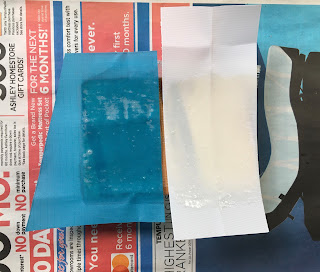Brightwork experiment ...
I am slowly removing, refinishing and reinstalling all the pieces of wooden brightwork on the boat. The latest piece was not just a refinish project but also a repair; the hatch cover for the starboard wet locker. This cover has a fitting for the auto-helm and at some point in the past when it was installed (or reinstalled), the teak hatch cover had cracked completely in two pieces lengthwise. It was temporarily repaired by screwing in a piece of steel strapping to both pieces on the backside, but it was flimsy and I wanted to do something more permanent.
Once I had sanded, prepped and stained both pieces, I attached them together along the seam with some JB Weld epoxy and after that dried, I laid a piece of biaxial FRP cloth across the seam on the backside and coated the entire piece with West System 105/205 epoxy. The result was a much sturdier repair.
 |
| Back view |
 |
| Front view |
With the hardware installed; you can see the fitting for the autohelm on the right:
With fiberglass projects I’ve done in the past, I have occasionally used “peel ply” to give a nice finish to the glassed surface. For anyone who hasn’t used peel ply, you lay it down on the fiberglass cloth once it’s been thoroughly soaked with epoxy. The peel ply keeps the cloth evenly wetted as it sets (preventing voids and air bubbles), soaks up any excess epoxy (saving weight), and once the epoxy dries, you just peel it off and it leaves behind a uniform, slightly opaque surface that needs little to no sanding or finishing. It also keeps the edges flat while drying so you don’t end up with any little spiky meat hooks along the perimeter of your work.
I never really knew what peel ply was made of, but it felt like nylon or polyester. I had some leftover ripstock nylon and Dacron edge tape from making the sail, so I decided to see if either (or both) were a viable substitute for peel ply. I coated some scrap wood with epoxy, laid on some biaxial glass cloth, wetted it thoroughly with the remainder of the epoxy, then covered half with nylon cloth (blue) and the other half with Dacron polyester (white):
Once everything dried, I tried to peel each off the wood. They both came off rather easily and left behind a nice finish with just enough texture to offer sufficient friction for a safe footfall (if needed). The Dacron worked a bit better, mostly because I think it’s just thicker and more substantial. I will certainly use this with any future FRP projects I have!



